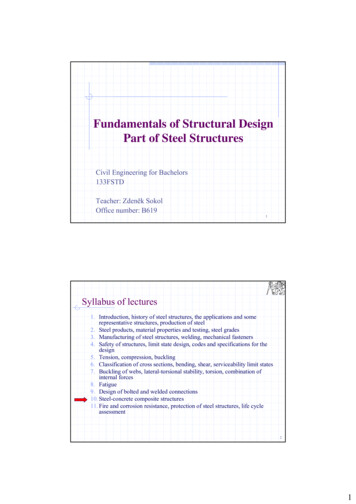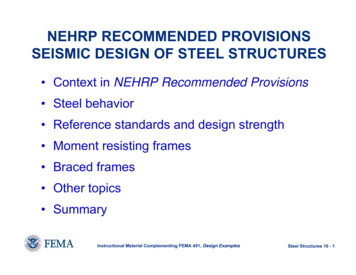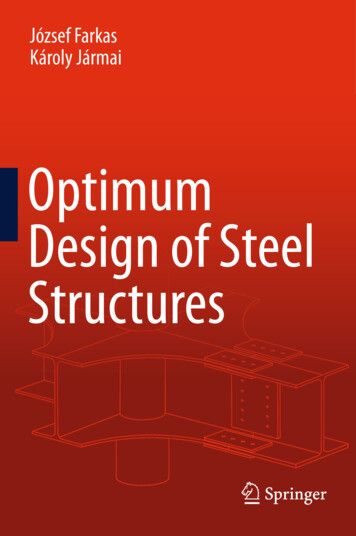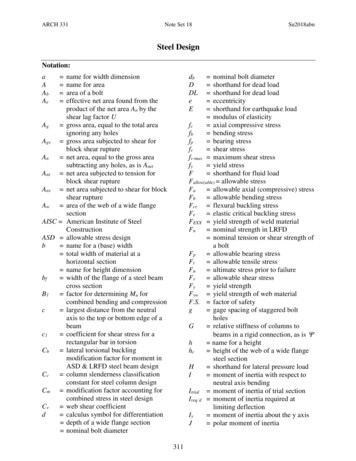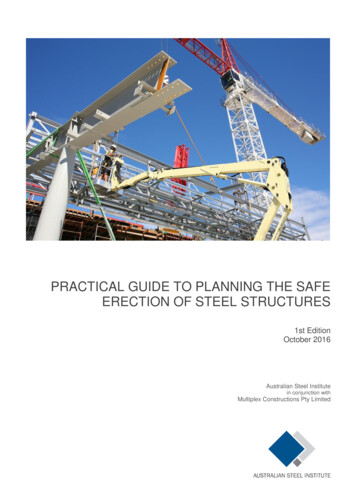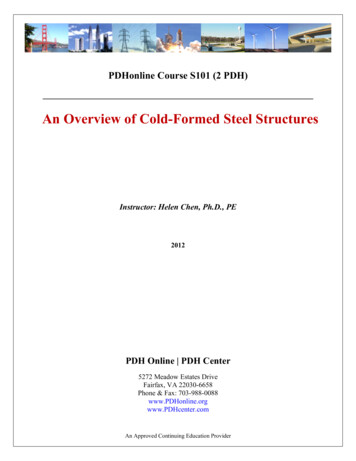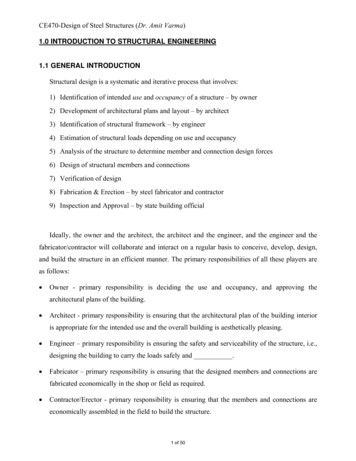
Transcription
CE470-Design of Steel Structures (Dr. Amit Varma)1.0 INTRODUCTION TO STRUCTURAL ENGINEERING1.1 GENERAL INTRODUCTIONStructural design is a systematic and iterative process that involves:1) Identification of intended use and occupancy of a structure – by owner2) Development of architectural plans and layout – by architect3) Identification of structural framework – by engineer4) Estimation of structural loads depending on use and occupancy5) Analysis of the structure to determine member and connection design forces6) Design of structural members and connections7) Verification of design8) Fabrication & Erection – by steel fabricator and contractor9) Inspection and Approval – by state building officialIdeally, the owner and the architect, the architect and the engineer, and the engineer and thefabricator/contractor will collaborate and interact on a regular basis to conceive, develop, design,and build the structure in an efficient manner. The primary responsibilities of all these players areas follows: Owner - primary responsibility is deciding the use and occupancy, and approving thearchitectural plans of the building. Architect - primary responsibility is ensuring that the architectural plan of the building interioris appropriate for the intended use and the overall building is aesthetically pleasing. Engineer – primary responsibility is ensuring the safety and serviceability of the structure, i.e.,designing the building to carry the loads safely and . Fabricator – primary responsibility is ensuring that the designed members and connections arefabricated economically in the shop or field as required. Contractor/Erector - primary responsibility is ensuring that the members and connections areeconomically assembled in the field to build the structure.1 of 50
CE470-Design of Steel Structures (Dr. Amit Varma) State Building Official – primary responsibility is ensuring that the built structure satisfies theappropriate building codes accepted by the Govt.1.2 STRUCTURAL DESIGN Conceptually, from an engineering standpoint, the parameters that can be varied (somewhat)are: (1) the material of construction, and (2) the structural framing plan. The choices for material include: (a) steel, (b) reinforced concrete, and (c) steel-concretecomposite construction. The choices for structural framing plan include moment resisting frames, braced frames, dualframes, shear wall frames, and so on. The engineer can also innovate a new structural framingplan for a particular structure if required. All viable material framing plan alternatives must be considered and designed to compare theindividual material fabrication / erection costs to identify the most efficient and economicaldesign for the structure. For each material framing plan alternative considered, designing the structure consists ofdesigning the individual structural components, i.e., the members and the connections, of theframing plan. This course CE470 focuses on the design of individual structural components. The material ofconstruction will limited be steel, and the structural framing plans will be limited to bracedframes and moment resisting frames.1.3 STRUCTURAL FRAMEWORK Figure 1 shows the structural plan and layout of a four-story office building to be located inLansing. Figure 2 and 3 show the structural elevations of frames A-A and B-B, respectively,which are identified in Figure 1.2 of 50
CE470-Design of Steel Structures (Dr. Amit Varma)RS10 ft.ETPJQO12 ft.DINHMGLFK12 ft.C12 ft.B15 ft.A25 ft.25 ft.Figure 2. Structural elevation of frame A-A3 of 50
CE470-Design of Steel Structures (Dr. Amit Varma)g10 ft. fenub1mta1lszkryjqxipwhov12 ft.d12 ft.c12 ft.b15 ft.a35 ft.35 ft.35 ft.Figure 3. Structural elevation of frame B-B As shown in Figure 1, the building has two 25-ft. bays in the north-south direction and three 35ft. bays in the east-west direction. There are four structural frames in the north-south direction. These frames have structuralelevations similar to frame A-A shown in Figure 2. There are three structural frames in the east-west directions. These frames have structuralelevations similar to frame B-B shown in Figure 3. The building has a roof truss, which is shown in Figures 2 and 3. Frame A-A is a braced frame, where all members are connected using pin/hinge connections.Diagonal bracing members are needed for stability. Frame B-B is a moment frame, where all members are connected using fix/momentconnections. There is no need for diagonal bracing members. The north-south and east-west frames resist the vertical gravity loads together. The three moment frames in the east-west direction resist the horizontal lateral loads in theeast-west direction.4 of 50
CE470-Design of Steel Structures (Dr. Amit Varma) The four braced frames in the north-south direction resist the horizontal lateral loads in thenorth-south direction.1.4 STRUCTURAL MEMBERSStructural members are categorized based up on the internal forces in them. For example: Tension member –subjected to tensile axial force only Column or compression member –subjected to compressive axial force only Tension/Compression member –subjected to tensile/compressive axial forces Beam member –subjected to flexural loads, i.e., shear force and bending moment only. Theaxial force in a beam member is negligible. Beam-column member – member subjected to combined axial force and flexural loads (shearforce, and bending moments)In basic structural analysis (CE305) students have come across two types of structures, namely,trusses and frames. For example, Figure 2 shows a roof truss supported by a braced frame. All the members of a truss are connected using pin/hinge connections. All external forces areapplied at the pins/hinges. As a result, all truss members are subjected to axial forces (tensionor compression) only. In braced and moment frames, the horizontal members (beams) are subjected to flexural loadsonly. In braced frames, the vertical members (columns) are subjected to compressive axial forcesonly. In braced frames, the diagonal members (braces) are subjected to tension/compression axialforces only. In moment frames, the vertical members (beam-columns) are subjected to combined axial andflexural loads.For practice, let us categorize the member shown in Figures 2 and 3.5 of 50
CE470-Design of Steel Structures (Dr. Amit Varma)RS10 ft.ETPOQJ12 ft.DINHMGLFK12 ft.C12 ft.B15 ft.A25 ft.25 ft.Figure 2. Structural elevation of frame A-Ag10 ft. fenub1mta1lszkryjqxipwhov12 ft.d12 ft.c12 ft.b15 ft.a35 ft.35 ft.Figure 3. Structural elevation of frame B-B6 of 5035 ft.
CE470-Design of Steel Structures (Dr. Amit Varma)1.5 STRUCTURAL CONNECTIONSMembers of a structural frame are connected together using connections. Prominent connectiontypes include: (1) truss / bracing member connections; (2) simple shear connections; (3) fullyrestrained moment connections; and (4) partially-restrained flexible moment connections. Truss / bracing member connections are used to connect two or more truss members together.Only the axial forces in the members have to be transferred through the connection forcontinuity. Simple shear connections are the pin connections used to connect beam to column members.Only the shear forces are transferred through the connection for continuity. The bendingmoments are not transferred through the connection. Moment connections are fix connections used to connect beam to column members. Both theshear forces and bending moments are transferred through the connections with very smalldeformations (full restraint). Partially restrained connections are flexible connections used to connect beam to columnmembers. The shear forces are transferred fully through the connection. However, the bendingmoment is only transferred partially.7 of 50
CE470-Design of Steel Structures (Dr. Amit Varma)Figure 5. Bracing connection and Simple Shear Connection at G in Frame A-A.8 of 50
CE470-Design of Steel Structures (Dr. Amit Varma)BeamColumnFigure 6. All-bolted double angle shear connection. Bevel Full penetration groove weld Field welding Weld access hole back-up barBeam fillet welds shear tabsColumnFigure 7. Directly welded flange fully restrained moment connection.9 of 50
CE470-Design of Steel Structures (Dr. Amit Varma) Figure 4 shows an example truss connection. Figure 5 shows an example bracingconnection. Figure 6 shows an example shear connection. Figure 7 shows an examplemoment connection. Connections are developed using bolts or welds. Bolts are used to connect two or more plate elements that are in the same plane. Bolt-holesare drilled in the plate elements. The threaded bolt shank passes through the holes, and theconnection is secured using nuts. Bolts are usually made of higher strength steel. Welds can be used to connect plate elements that are in the same or different planes. A highvoltage electric arc is developed between the two plate elements. The electric arc causeslocalized melting of the base metal (plate element) and the weld electrode. After cooling,all the molten metal (base and weld) solidifies into one continuum. Thus, developing awelded connection. In Figure 4, all the truss members are connected together by welding to a common gussetplate. The axial forces in the members are transferred through the gusset plates. This sameconnection can also be developed using bolts. How? In Figure 5, the bracing members are connected to gusset plates, which are also connectedto the beam and column. The bracing member can be connected to the gusset plate usingbolts or welds. However, the gusset plate has to be welded to the beam / column. In Figure 6, two angles are bolted to the web of the beam. The perpendicular legs of theangles are bolted to the flange of the column. Thus, an all-bolted double-angle shearconnection is achieved. This all-bolted connection will be easier to assemble in the field ascompared to welding. How is this a shear connection? In Figure 7, the beam flanges are beveled and welded directly to the flange of column usingfull penetration groove welds. This welding will have to be done in the field during erectionand it will require the use of back-up bars. Weld-access holes and skilled welders arerequired to achieve a weld of acceptable quality. In Figure 7, the beam web is bolted to a shear tab (plate), which is fillet welded to thecolumn in the shop. This shear tab connection transfers the shear from the beam to thecolumn. How is Figure 7 a moment connection?10 of 50
YZXZYX11 of 501
ZYXZYX12 of 502
ZXELEVATION OF BRACED FRAMEZYELEVATION OF MOMENT FRAME13 of 503
YXPLAN OF ROOF TRUSSELEVATION OF BRACED FRAMEZYELEVATION OF MOMENT FRAMEXPLAN OF ROOF TRUSS14 of 504
ZXYZZXYXYZZYXYX15 of 505
W16 of 506
ZYXZWXYWZXYWZYX17 of 507
WZZXYYXZYX18 of 508
CE470-Design of Steel Structures (Dr. Amit Varma)1.6 Structural LoadsThe building structure must be designed to carry or resist the loads that are applied to it over itsdesign-life. The building structure will be subjected to loads that have been categorized as follows: Dead Loads (D): are permanent loads acting on the structure. These include the self-weight ofstructural and non-structural components. They are usually gravity loads. Live Loads (L): are non-permanent loads acting on the structure due to its use and occupancy.The magnitude and location of live loads changes frequently over the design life. Hence, theycannot be estimated with the same accuracy as dead loads. Wind Loads (W): are in the form of pressure or suction on the exterior surfaces of the building.They cause horizontal lateral loads (forces) on the structure, which can be critical for tallbuildings. Wind loads also cause uplift of light roof systems. Snow Loads (S): are vertical gravity loads due to snow, which are subjected to variability dueto seasons and drift. Roof Live Load (Lr): are live loads on the roof caused during the design life by planters,people, or by workers, equipment, and materials during maintenance. Values of structural loads are given in the publication ASCE/SEI 7-10: Minimum Design Loadsfor Buildings and Other Structures. The first phase of structural design consists of estimatingthe loads acting on the structure. This is done using the load values and combinations presentedin ASCE/SEI 7-10 as explained in the following sub-sections.19 of 50
CE470-Design of Steel Structures (Dr. Amit Varma)1.6.1 Step I. Categorization of Buildings Categories I, II, III, and IV. See Table 1.5-1 below and in ASCE/SEI 7-10.1.6.2 Dead Loads (D)Dead loads consist of the weight of all materials of construction incorporated into the buildingincluding but not limited to walls, floors, roofs, ceilings, stairways, built-in partitions, finishes,cladding and other similarly incorporated architectural and structural items, and fixed serviceequipment such as plumbing stacks and risers, electrical feeders, and heating, ventilating, and airconditioning systems.In some cases, the structural dead load can be estimated satisfactorily from simple formulasbased in the weights and sizes of similar structures. For example, the average weight of steelframed buildings is 60-75 lb/ft2, and the average weight for reinforced concrete buildings is 110 130 lb/ft2.From an engineering standpoint, once the materials and sizes of the various components of thestructure are determined, their weights can be found from tables that list their densities. See Tables1.2 and 1.3, which are taken from Hibbeler, R.C. (1999), Structural Analysis, 4th Edition.20 of 50
CE470-Design of Steel Structures (Dr. Amit Varma)1.6.3 Live Loads Building floors are usually subjected to uniform live loads or concentrated live loads. Theyhave to be designed to safely support the minimum uniformly distributed load or the minimumconcentrated live load values given in the ASCE/SEI 7-10 (see Table 4.1 below), whicheverproduces the maximum load effects in the structural members.21 of 50
CE470-Design of Steel Structures (Dr. Amit Varma)22 of 50
CE470-Design of Steel Structures (Dr. Amit Varma)23 of 50
CE470-Design of Steel Structures (Dr. Amit Varma)24 of 50
CE470-Design of Steel Structures (Dr. Amit Varma) The minimum uniformly distributed live loads (Lo) given in Table 4.1 above can be reduced forbuildings with very large floor areas, because it is unlikely that the prescribed live load willoccur simultaneously throughout the entire structure. Equation (1.1) can be used to calculate the reduce uniformly distributed live load (L) formembers with KLLAT 400 ft2: 15L Lo 0.25 K LL AT (1.1)where, AT is the tributary area in ft2 and KLL is the live load element factor as follows:KLL is equal to 4.0 for interior columns and exterior columns without cantilever slabs. KLL isequal to 3.0 for edge columns with cantilever slabs.KLL is equal to 2.0 for corner columns with cantilever slabs, edge beams without cantileverslabs, and interior beams.KLL is equal to 1.0 for all other members not identified above.EXCEPTION: Equation 1.1(a) can be used instead of Equation 1.1 for members of oneand two-family structures supporting more than one floor load.L 0.7 ( Lo1 Lo 2 .)(1.1(a))Lo1, Lo2 unreduced floor live load applicable to each of the supported story levelirrespective of the tributary area.L the largest unreduced floor live load on a given story level acting alone Some limitations to the live load reduction are as follows:L cannot be less than 0.5Lo for members supporting one floor and L cannot be less that 0.4Lofor members supporting two or more floors.Live loads that exceed 100 lb/ft2 shall not be reduced except the live loads for memberssupporting two or more floors may be reduced by 20%.Live loads shall not be reduced for passenger vehicle garages except the live loads for memberssupporting two or more floors may be reduced by 20%.Live loads shall not be reduced in assembly uses.25 of 50
CE470-Design of Steel Structures (Dr. Amit Varma)Example 1.1 Determine the magnitude and distribution of live loading on the north-south framebi - ei - hiNOTES:1) The live loading on the beams bi - ei and ei – hi can be calculated using the reduced floor liveload and the tributary area for the beams supporting the floors.2) The live loads acting on beams di – ei and ei - fi can be used to determine the concentratedlive load reactions on columns di, ei, and fi-Where, the live loads acting on the beams di – ei and ei - fi are calculated using thereduced floor live load and the corresponding tributary area for the beams3) The concentrated live load acting on the columns can also be estimated directly using thereduced live load and the tributary area for the columns.-But, this method would be inconsistent because the live load carried by the beams bi-eiand ei-hi would be included twice.-Additionally, the live load reduction factor calculated directly for the columns will bedifferent from the live load reduction factors calculated for the beams. Consider theTables developed in this example. Step I: Determine relevant tributary and influence areas. Estimate live load reduction factors.hidiA T 9337.5 ft2eei25 ft.AT 937.5 ft2A T 312.5iA T 468.75 ft2aiAT 468.75 ft2AT 312.5 ft2AT 468.75 ft2iift2gi4fi25 ft.AT 468.75 ft2hcibi50 ft.50 ft.26 of 50
CE470-Design of Steel Structures (Dr. Amit Varma)Table 1.1 Member tributary areas and minimum design live loading.Tributary areaKLLL/Lo 0.25 15.0/(KLLAT)0.5L/Lo min.bi-eiAT ½ x 25.0 x 12.5 x 22.00.850.5ei-hi 312.5 ft2di - eiAT ½ x 12.5 x 25.0 x 2 2.00.600.5ei - fi25.0 x 25.0 937.5 ft22.00.740.52.01.00.5BeamMembergi - hihi - iiAT ½ x (50 25) x 12.5ai - bi 468.75 ft2bi - ciai - didi - giAT ½ x 25.0 x 12.5ci - fi 156.25 ft2fi - iiStep II. Estimate the distributed loads acting on the beams bi - ei and ei - hib6e6h6b5e5h5b4e4h4b3e3h3b2e2h2b1e1h1(0.85x50 x12.5)/1000 0.53k/ft.bi27 of 50ei
CE470-Design of Steel Structures (Dr. Amit Varma)Step III: Estimate the concentrated live loads acting on the columns of frame bi-ei-hi, which areproduced by the live load distribution on the beams of the orthogonal frames di-ei-fi , ai-bi-ci , andgi-hi-ii(0.60x50x25)/1000 0.75k/ft.d6e628.125 kf6d5e528.125 kf5d4e428.125 kf4d3e328.125 kf3d2e2Resultantf225’12.5’12.5’14.0625 k14.0625 k0.60x50x25 0.75k/ft.28.125 kd1e1f125’12.5’14.0625 ka6a5a4a3a2a112.5’14.0625 k0.74x50 x12.5 0.46k/ftc6b617.34 kb517.34 kb417.34 kc4b317.34 kc3b2Resultantc2c512.5’25’12.5’8. 67 k8.67 k0.74x50 x12.5 0.46k/ft17.34 kc1b112.5’8.67 kThus, the concentrated live loads acting on columns bi and hi are 17.34 kipsThe concentrated live loads acting on columns ei are 28.125 k28 of 5025’12.5’8.67 k
CE470-Design of Steel Structures (Dr. Amit Varma)Step IV: Check the estimated column live loadings with values that would be obtained directlyfor the columnshigiiiAT 12.5 x 50 625 ft225 ft.AT 25 x 50 1250 ft2eidifi25 ft.AT 12.5 x 50 625 ft2aicibi50 ft.50 ft.ColumnTributary areaKLLL/Lo 0.25 15.0/(KLLAT)0.5L/Lo min.AT 12.5 x 50 625 ft24.00.550.4Memberbi0.5 for b6, h6hiAT 25 x 50 1250 ft2ei4.00.460.40.5 for e6Live load acting on column bi and hi are 0.55 x 50 psf x 625 17.18 kipsLive load acting on column ei 0.46 x 50 psf x 1250 28.75 kips-Live load acting on column e6 0.5 x 50 psf x 1250 31.25 kips Note that the live loads calculated in Steps I, II, and III are consistent and to be used fordesign. The concentrated live load calculated in Step IV are just to check that the loadscalculated in Steps I, II, and III are more than the loads calculated in Step IV.29 of 50
CE 470: Design of Steel Structures – Dr. Amit Varma1.6.4 Roof Live LoadsOrdinary flat, pitched, and curved roofs shall be designed for the live loads specified inEquation 1.2 (from ASCE/SEI 7-10).Lr 20 R1 R2where, 12 Lr 20(1.2)where,Lr is the roof live load per square foot of horizontal projection in psf.R1 1for AT 200 ft2 1.2 - 0.001 ATfor 200 AT 600 ft2 0.6for 600ft2 ATR2 1for F 4 1.2 - 0.05 Ffor 4 F 12 0.6for 12 Fwhere, F no. of inches of rise per foot for pitched roof. 1.6.5 Wind Loads Design wind loads for buildings can be based on: (a) simplified procedure; (b) analyticalprocedure; and (c) wind tunnel or small-scale procedure. Figure 26.1-1 (ASCE/SEI 7-10) outlines the process for determining wind loads.30 of 50
CE 470: Design of Steel Structures – Dr. Amit Varma Refer to ASCE/SEI 7-10 for the simplified procedure. This simplified procedure is applicableonly to buildings with mean roof height less than 30 ft. The wind tunnel procedure consists of developing a small-scale model of the building andtesting it in a wind tunnel to determine the expected wind pressures etc. It is expensive andmay be utilized for difficult or special situations. The analytical procedure is used in most design offices. It is fairly systematic but somewhatcomplicated to account for the various situations that can occur. Wind velocity will cause pressure on any surface in its path. The wind velocity and hence thevelocity pressure depend on the height from the ground level. Equation 1.3 is recommendedby ASCE/SEI 7-10 (Equation 27.3-1) for calculating the velocity pressure (qz) in lb/ft2qz 0.00256 Kz Kzt Kd V2where, V is the basic wind speed(lb/ft2)(1.3)(see Figure 26.5-1 in ASCE/SEI 7-10 )31 of 50
CE 470: Design of Steel Structures – Dr. Amit VarmaKd is a wind directionality factor( 0.85 for CE 470)Kzt is a topographic factor( 1.0 for CE 470)Kz varies with height z above the ground level and Exposure category (see Table 27.3-1in ASCE/SEI 7-10 ) Basic Wind Speed (V) :o For Risk Category II buildings and structures – use Fig. 26.5-1Ao For Risk Category III and IV buildings and structures – use Fig. 26.5-1Bo For Risk Category I buildings and structures – use Fig. 26.5-1C A significant portion of the U.S. including West Lafayette has V 115 mph for RiskCategory II (Fig. 26.5-1A). At these locations, for Risk Category IIqz 28.78 Kz(lb/ft2)32 of 50(1.4)
CE 470: Design of Steel Structures – Dr. Amit Varma The velocity pressure qz is used to calculate the design wind pressure (p) for the buildingstructure as follows:p q GCp – qi (GCpi)(lb/ft2)(1.5)where, G gust effect factor ( 0.85 for CE 470)Cp external pressure coefficient from Figures 27.4-1, 27.4-2 and 27.4-3in ASCE/SEI 710(GCpi ) internal pressure coefficient from Table 26.11-1 in ASCE/SEI 7-10q depends on the orientation of the building wall or roof with respect to direction of thewind as follows:q qz for the windward wall – varies with height zq qh for leeward wall.qh is qz evaluated at z h (mean height of building). qh is constant.qi qh for windward, leeward, side walls and roofs (fully enclosed building) Note that a positive sign indicates pressure acting towards a surface. Negative sign indicatepressure away from the surface Equation 1.5 indicates that the design wind pressure p consists of two components: (1) theexternal pressure on the building (q GCp); and (2) the internal pressure in the building(qiGCpi)33 of 50
CE 470: Design of Steel Structures – Dr. Amit VarmaASCE/SEI 7-10 Figure 26.8-1 (Pg. 252-253)34 of 50
CE 470: Design of Steel Structures – Dr. Amit Varma35 of 50
CE 470: Design of Steel Structures – Dr. Amit VarmaFigure showing the Basic Wind Speed map of US (Category II Buildings). (ASCE/SEI 7-10Pages 290-291)36 of 50
CE 470: Design of Steel Structures – Dr. Amit Varma37 of 50
CE 470: Design of Steel Structures – Dr. Amit VarmaExternal Pressure Coefficients Figures 27.4-1, 2 &3 (ASCE/SEI 7-10 Pages.263-266)38 of 50
CE 470: Design of Steel Structures – Dr. Amit Varma39 of 50
CE 470: Design of Steel Structures – Dr. Amit Varma40 of 50
CE 470: Design of Steel Structures – Dr. Amit Varma41 of 50
CE 470: Design of Steel Structures – Dr. Amit VarmaWind Directionality Factor (ASCE/SEI 7-10 Page 250)42 of 50
CE 470: Design of Steel Structures – Dr. Amit VarmaVelocity Pressure Exposure Coefficient (ASCE/SEI 7-10, Page 261)43 of 50
CE 470: Design of Steel Structures – Dr. Amit VarmaInternal Pressure Coefficient for buildings (ASCE/SEI 7-10. Page 258)44 of 50
CE 470: Design of Steel Structures – Dr. Amit VarmaExample 1.2Consider the building structure with the structural floor plan and elevation shown below.Estimate the wind loads acting on the structure when the wind blows in the east-west direction.The structure is located in West Lafayette.higiNii25 ft.difiei25 ft.aicibi50 ft.50 ft.Figure 8. Structural floor plan10 ft.10 ft.10 ft.10 ft.a6b6c6a5b5a4b4c4a3b3c3a2b2c2a1b1c1c510 ft.15 ft.Figure 9. Structural elevation in east-west direction45 of 50E
CE 470: Design of Steel Structures – Dr. Amit Varma10 ft.b6e6g6b5e5g5b4e4g4b3e3g3b2e2g2b1e1g110 ft.10 ft.10 ft.10 ft.15 ft.Figure 10. Structural elevation in north-south direction Velocity pressure (qz)-Kd directionality factor 0.85-Kzt topographic factor 1.0-Kh values for Exposure B, Case 2Khz(ft)0.57 0 - 15 0.62200.66250.70300.76400.81500.85600.8970qz 0.00256 Kz Kzt Kd V2-In West Lafayette, V 115 mph for Risk Category II (Fig. 26.5-1A)-qz 28.78 Kz psf46 of 50N
CE 470: Design of Steel Structures – Dr. Amit Varma Wind pressure (p)-Gust factor G 0.85-For wind in east west direction; L/B Length / width 2.0-External pressure coefficient Cp 0.8 for windward wallsCp -0.3 for leeward wallsCp -0.7 for side walls-External pressure q G Cp-External pressure on windward wall qz GCp 28.78 Kz x 0.85 x 0.8 19.57 Kz psf toward surface-External pressure on leeward wall qh GCp 28.78 K65 x 0.85 x (-0.3) 6.38 psf away from surface-External pressure on side wall qh GCp 28.78 K65 x 0.85 x (-0.7) 14.90 psf away from surface-The external pressures on the structure are shown in Figures 11 and 12 below.Figure 11. External pressures on structural plan47 of 50
CE 470: Design of Steel Structures – Dr. Amit VarmaFigure 12. External pressure on structural elevation (east west) Internal pressure-qi (GCpi)-qi qh 28.78 K65 28.78 x 0.87 25.04 psf-Enclosed building;GCpi 0.18 (acting toward surface)GCpi -0.18 (acting away from surface)-qi (GCpi) 4.51 psf acting toward or away from surface-See Figure 13 (a) and (b) below(a)(b)Figure 13. Internal pressure seen in structural plan Take the external pressure from Figure 11 and 12 and add to internal pressure from Figures13 (a) and (b) to obtain the final pressure diagrams. Adding the internal pressure will notchange the lateral forces in the structure.48 of 50
CE 470: Design of Steel Structures – Dr. Amit Varma(a)(b)Figure 14. Resultant wind pressure diagrams including external and internal pressures Note: According to ASCE/SEI 7-10, the minimum wind design loading is equal to 16 lb/ft2multiplied by the area of the building projected on a vertical plane normal to assumed winddirection. Compare the determined design wind loading with the minimum value and continue with thegreater as the design wind loading.1.7 Load and Resistance Factor DesignThe load and resistance factor design approach is recommended by AISC for designing steelstructures. It can be understood as follows:Step I. Determine the ultimate loads acting on the structure-The values of D, L, W, etc. given by ASCE/SEI 7-10 are nominal loads (not maximum orultimate)-During its design life, a structure can be subjected to some maximum or ultimate loadscaused by combinations of D, L, or W loading.-The ultimate load on the structure can be calculated using factored load combinations,which are given by ASCE and AISC (see pages 2-10 and 2-11 of AISC manual). Themost relevant of these load combinations are given below:1.4 D1.2 D 1.6 L 0.5 (Lr or S)49 of 50(1.6 – 1)(1.6 – 2)
CE 470: Design of Steel Structures – Dr. Amit Varma1.2 D 1.6 (Lr or S) (0.5 L or 0.5 W)(1.6 – 3)1.2 D 1.0W 0.5 L 0.5 (Lr or S)(1.6 – 4)0.9 D 1.0 W(1.6 – 5)Step II. Conduct linear elastic structural analysis-Determine the design forces (Pu, Vu, and Mu) for each structural memberStep III. Design the members-The failure (design) strength of the designed member must be greater than thecorresponding design forces calculated in Step II. See Equation (1.7) below: Rn i Qi(1.7)-Where, Rn is the calculated failure strength of the member- is the resistance factor used to account for the reliability of the material behavior andequations for Rn-Qi is the nominal load- i is the load factor used to account for the variability in loading and to estimatethe ultimate loading condition.50 of 50
CE470-Design of Steel Structures (Dr. Amit Varma) 1.6 Structural Loads The building structure must be designed to carry or resist the loads that are applied to it over its design-life. The building structure will be subjected to loads that have been categorized as follows: Dead Loads (D): are permanent
